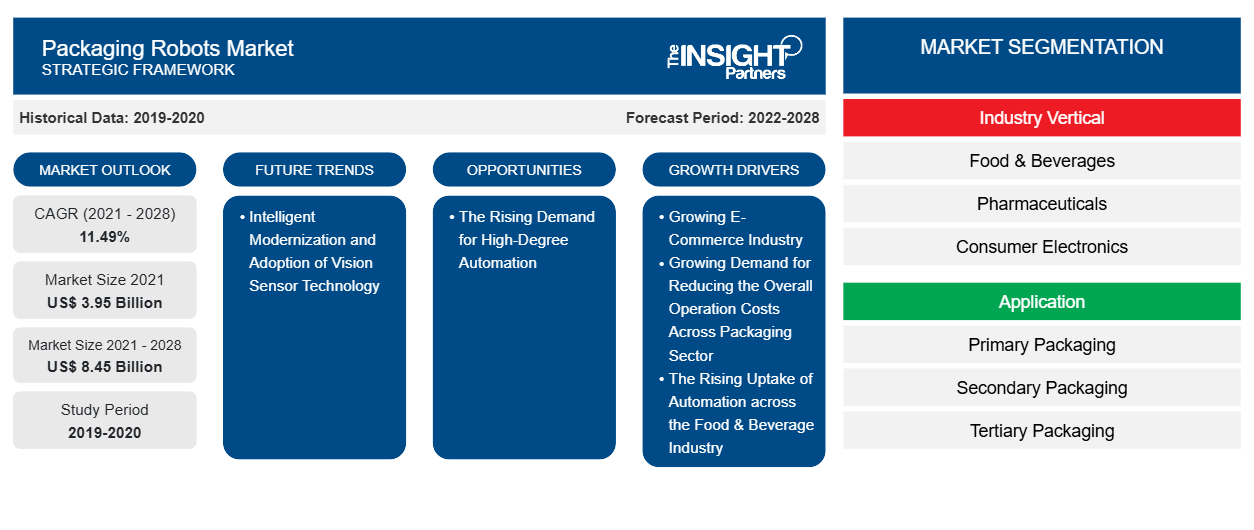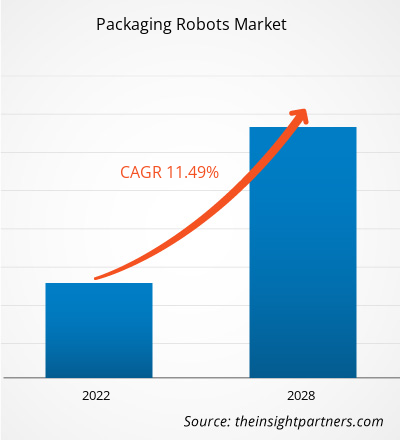[調査レポート] 包装ロボット市場は、2021年の39億4,543万米ドルから2028年には84億4,821万米ドルに成長すると予想されており、2021年から2028年にかけて11.49%のCAGRで成長すると予測されています。
アナリストの視点:
包装ロボットは、マテリアルハンドリング作業に正確性、スピード、生産性をもたらします。そのため、さまざまなメーカーがスループットを向上させるために包装ロボットを導入しています。また、包装ロボットは一度に多くの製品を持ち上げることができるため、手作業よりもはるかに高い稼働時間を提供し、人件費と全体的な運用の人件費を削減し、包装ロボット市場の成長を後押しします。さらに、食品および飲料業界では、何百ものパッケージやボトルに詰めたり、他の複雑な作業を人間よりも効率的に実行したりするために協働ロボットの使用が増えており、包装ロボット市場の成長を促進しています。また、世界中で成長する電子商取引業界も、包装ロボット市場の成長を促進するもう1つの要因です。さらに、高度な自動化に対する需要の高まりにより、予測期間中に包装ロボット市場の成長の機会が生まれると予想されます。
市場概要:
梱包ロボットは、さまざまな保管場所から物体を拾い上げて棚に置くために、事前に定義されたルートに沿って移動するようにプログラムされたロボットです。これらのロボットは人間の支援なしで動作し、生産ラインを合理化し、余分な人間の介入の必要性を減らすことで時間を節約するのに役立ちます。速度、精度、生産性を提供することで、さまざまな産業分野に多くの重要な利点を提供し、適切に導入された場合は比較的迅速な投資収益率 (ROI) を実現します。エンド オブ アーム ツール (EOAT) に応じて、梱包ロボットはさまざまなタスクを実行できます。ほとんどの場合、梱包ロボットは、製品パッケージの開封、充填、輸送、パレット化、密封、コード化、ラベル付けを行うように設計されています。上記の利点のため、製品の完全性を保護するために製品を正確に、一貫して、高品質に梱包する必要がある分野で最も一般的に使用されています。産業分野では、サイクル タイムを短縮して生産性を向上させるために梱包ロボットが頻繁に使用されており、食品および飲料業界でも同様の理由で梱包ロボットを使用しています。
要件に合わせてレポートをカスタマイズする
このレポートの一部、国レベルの分析、Excelデータパックなど、あらゆるレポートを無料でカスタマイズできます。また、スタートアップや大学向けのお得なオファーや割引もご利用いただけます。
- このレポートの主要な市場動向を入手してください。この無料サンプルには、市場動向から見積もりや予測に至るまでのデータ分析が含まれます。
包装ロボット市場の推進力:
食品・飲料業界における自動化の導入増加が包装ロボット市場の成長を牽引
食品・飲料業界における自動化とは、検査、包装、保管など、さまざまな生産プロセスにわたる技術の統合を指します。長年にわたり、食品・飲料会社は、さまざまな規制機関によって定められた食品の安全性 と品質の基準に準拠し、生産現場全体の人件費を削減するために、無人搬送車、デルタロボット、ロボットアームなどの自動化システムを統合することで、さまざまな生産プロセスを最適化してきました。
さらに、包装された食品や飲料には、人間にとって難しい高精度で反復的な包装プロセスが必要です。このため、一次包装、二次包装、パレタイジングなど、さまざまな作業にロボット技術の需要が高まっています。
また、 視覚誘導ロボットは、ビンピッキング、ボトルハンドリング、トレイローディングなどのさまざまな反復タスクを効率的に完了できるため、食品および飲料業界全体で需要が高まっています。さらに、効率性の向上、トレーサビリティの強化、高い柔軟性など、多くの利点により、食品および飲料業界での自動化のニーズが高まっています。このような要因により、食品および飲料メーカーは、生産施設全体で自動化技術の統合への投資を増やすよう促されています。たとえば、2021年に米国を拠点とするスナックブランドのUtz Brands Inc.は、全体的な運用コストを削減するために、生産工場全体に自動化ソリューションを統合する計画を発表しました。同様に、2022年には、Hormel Foodsも生産施設全体に自動化を組み込む計画を発表しました。Tyson FoodsやCargill Inc.などの他の食品および飲料ブランドも、自動化技術の採用に取り組んでいます。このように、食品および飲料業界全体での自動化への投資の増加は、包装ロボット市場の成長を促進しています。
セグメント分析:
業界別では、包装ロボット市場は食品・飲料、医薬品、家電製品、その他に分類されています。食品・飲料部門は2021年に最大の市場シェアを占めましたが、医薬品部門は2021~2028年に最高のCAGRを記録すると予想されています。食品・飲料業界では、自動化ソリューションの急速な統合が進んでいます。包装ロボットは、品質管理を確保しながら包装を高速化します。包装ロボットの統合により作業者の安全性も向上し、エンドツーエンドのトレーサビリティにより、生産量、廃棄物の削減、人件費が向上し、生産の柔軟性が向上します。これらの利点により、さまざまな食品会社が、視覚誘導ロボットアーム、無人搬送車、デルタロボット、高度な検査システムを使用してプロセスの最適化に取り組んでおり、食品の安全性と品質基準を確保し、増え続ける需要に対応しています。このように、食品・飲料業界では、既存のインフラストラクチャをアップグレードするために自動化の採用が増えており、市場の成長を促進しています。
地域分析:
アジア太平洋地域では、予測期間中に梱包ロボット市場が大幅に成長すると予想されています。この地域では、中国が2021年に最大の市場シェアを占め、インドは2021年から2028年の間に最高のCAGRを記録するでしょう。生産性の向上とコスト削減のための自動化への投資の増加は、メーカーが高まる消費者の需要を満たすのに役立っています。また、ロボットの統合は梱包効率の向上と運用コストの削減に役立つため、さまざまな業界分野での需要が増加しています。さらに、自動化の需要は、この地域で繁栄しているeコマース業界によって推進されています。国際航空運送協会(IATA)によると、APACは世界のeコマース市場の成長をリードしており、中国が成長のかなりの割合を占めています。国際貿易局によると、中国のeコマース市場は世界最大であり、世界の取引のほぼ50%を生み出しています。同様に、APACの他の国のeコマース市場も大幅な成長を遂げています。たとえば、国際貿易局によると、世界で 11 番目に大きい電子商取引市場であるオーストラリアは、2024 年までに 323 億米ドルに達すると予想されています。インド ブランド エクイティ財団 (IBEF) によると、インドの電子商取引市場は 2025 年までに 1,880 億米ドルに達すると予想されています。このように、自動化と電子商取引業界の成長が、APAC の市場成長を牽引しています。
主要プレーヤー分析:
ABB Ltd、Brenton Engineering、FANUC Corporation、Krones AG、KUKA Roboter GmbH、三菱電機株式会社、Remtec Automation LLC、Robert Bosch GmbH、Schnider Electric、およびYaskawa Americaは、主要な包装ロボット市場のプレーヤーです。これらの包装ロボット市場のプレーヤーは、継続的な製品開発と革新に重点を置いています。
包装ロボット市場の地域別分析
予測期間を通じて包装ロボット市場に影響を与える地域的な傾向と要因は、Insight Partners のアナリストによって徹底的に説明されています。このセクションでは、北米、ヨーロッパ、アジア太平洋、中東、アフリカ、南米、中米にわたる包装ロボット市場のセグメントと地理についても説明します。

- 包装ロボット市場の地域別データを入手
包装ロボット市場レポートの範囲
| レポート属性 | 詳細 |
|---|---|
| 2021年の市場規模 | 39億5千万米ドル |
| 2028年までの市場規模 | 84.5億米ドル |
| 世界のCAGR(2021年~2028年) | 11.49% |
| 履歴データ | 2019-2020 |
| 予測期間 | 2022-2028 |
| 対象セグメント | 業種別
|
| 対象地域と国 | 北米
|
| 市場リーダーと主要企業プロフィール |
|
包装ロボット市場のプレーヤー密度:ビジネスダイナミクスへの影響を理解する
包装ロボット市場は、消費者の嗜好の変化、技術の進歩、製品の利点に対する認識の高まりなどの要因により、エンドユーザーの需要が高まり、急速に成長しています。需要が高まるにつれて、企業は提供を拡大し、消費者のニーズを満たすために革新し、新たなトレンドを活用し、市場の成長をさらに促進しています。
市場プレーヤー密度とは、特定の市場または業界内で活動している企業または会社の分布を指します。これは、特定の市場スペースに、その市場規模または総市場価値に対してどれだけの競合相手 (市場プレーヤー) が存在するかを示します。
包装ロボット市場で事業を展開している主要企業は次のとおりです。
- ABB社
- ブレントン LLC
- ファナック株式会社
- クロネスAG
- クーカAG
免責事項:上記の企業は、特定の順序でランク付けされていません。

- 包装ロボット市場のトップキープレーヤーの概要を入手
最近の動向:
市場の企業では、製品の発売、パートナーシップ、コラボレーション、合併や買収などの無機的および有機的な戦略が広く採用されています。これらの企業による最近の主要な市場動向をいくつか以下に示します。
- 2023年4月、シェメシュは、あらゆる形状やサイズの化粧品の供給、充填、キャップ、ラベル付け、ケース梱包、パレット積み込みなど、包装プロセス全体を処理するように設計された、ロボットを活用した化粧品向け完全包装ラインTKS-C60の発売を発表しました。TKS-C60は、クリームやファンデーションから香水やマニキュアまで、さまざまな製品を1分間に60本の速度でシームレスに中断なく充填するラインを実現します。
- 2023 年 3 月、カスタム ボトリングおよびパッケージング業界向けの自動化システム メーカーである Proco Machinery は、パッケージング業界で深刻化する労働力不足に対処するため、新しい協働ロボット パッカーの発売を発表しました。この新しい Proco 協働ロボット パッカーは、人間のオペレーターと一緒に作業して効率とパフォーマンスを向上させるように設計されています。新しいロボット パッカーは、容器のテストからケースへの梱包まで、さまざまなタスクを実行できます。
- 2023年2月、ラピッド・ロボティクスはユニバーサルロボット(UR)との新しいパートナーシップを発表しました。このパートナーシップでは、デンマークの協働ロボット(コボット)メーカーが、北米全域に展開するラピッド・ロボティクスのコボット作業セル向けに協働ロボットアームを供給することになります。また、ユニバーサルロボットの導入により、ラピッド・ロボティクスはより多くの顧客にサービスを提供できるようになり、全国展開が拡大し続けても、顧客が期待する迅速な展開時間を維持できるようになります。これらの協働ロボットには、パレタイジング、箱作りと梱包、より重い積載量やより長いリーチを必要とする作業など、さまざまな機能があります。
- 2022年11月、eコマース向けAI駆動型ロボットの世界的リーダーであるOSAROは、eコマースおよび物流事業向けのピックアンドプレースロボットシステムの統合を加速するために、SVT Roboticsとの提携を発表しました。SVT Roboticsの画期的なSOFTBOTプラットフォームにより、企業は必要なロボット、自動化、IoTデバイスをわずか数日または数週間で統合して導入できます。契約の一環として、SVT RoboticsはOSAROのパートナープログラムに参加しました。このプログラムは、フルフィルメント業務にロボットソリューションを導入したい企業にワンストップアクセスを提供します。
- 2022 年 7 月、ABB は FlexPicker Delta ロボット ポートフォリオを IRB 365 で拡張すると発表しました。5 軸で 1.5kg の可搬重量を備えた IRB 365 は、クッキー、チョコレート、ピーマン、キャンディー、小瓶、小包などのパッケージ化された軽量製品の向きを変えるのに柔軟性とクラス最速の両方を備えています。IRB 365 は、e コマースの増加と棚にすぐに並べられるパッケージ化された商品に対する需要の高まりに対応して、生産ラインの速度と適応性が不可欠な食品や飲料、医薬品、消費財などのアプリケーション向けに開発されました。
- 過去2年間の分析、基準年、CAGRによる予測(7年間)
- PEST分析とSWOT分析
- 市場規模価値/数量 - 世界、地域、国
- 業界と競争環境
- Excel データセット



Report Coverage
Revenue forecast, Company Analysis, Industry landscape, Growth factors, and Trends

Segment Covered
This text is related
to segments covered.

Regional Scope
North America, Europe, Asia Pacific, Middle East & Africa, South & Central America

Country Scope
This text is related
to country scope.
よくある質問
The Asia Pacific packaging robots market was estimated to be the largest as well as fastest growing regions in the global packaging robots market in 2020, according to the research study. The packaging robots’ market in Asia-Pacific (APAC) is further sub-segmented into Australia, China, India, Japan, South Korea, and the Rest of Asia Pacific. The region holds the largest market share owing to well established manufacturing sector. A continuous rise in increasing disposal income across economies such as India and China are resulting in elevated consumer demand for diverse range of products. In addition, the availability of cheap laborers in the region attracts many foreign manufacturers to establish their manufacturing bases in the region. Increased investments in automation to reduce costs and improve productivity is driving the manufacturers to meet the growing consumer demands. The integration of robots improves packaging efficiency and reduces operational costs.
The food and beverage industry is witnessing rapid integration of automation solutions, including vision-guided robotic arms, packaging robots and advanced inspection systems to streamline and optimize operations. Food and beverage industry is one of the early adopters of advanced technologies. Factories in the developed nations are investing in the smart factory concept by integrating mobile devices, sensors, and connectivity devices. Before the industrial 4.0. automation in the food industry was achieved through end-of-line technologies such as computer mechanical bagging systems. One-third of processing operations employ robots, according to research by Association for Packaging and Processing Technologies..
Primary packaging is the first layer that contains the finished product and preserves it from contamination. The packaging is intended for consumers to communicate important information about the products and make it more appealing. Factor such as production parameters, product’s attributes and how products are delivered to and from the packaging equipment is crucial while considering the automation of a packaging process. Automating primary packaging through robots offers greater flexibility and provides a product to be placed in any configuration.
Packaging is a critical procedure in manufacturing facilities, especially those that produce goods for the consumer market. The installation of a robotic packaging system increases flexibility and improves the packaging line's overall production. Furthermore, packaging robots can work in a variety of temperatures and take up significantly less floor area than people. Increased demand for various items is forcing enterprises to focus on improving production efficiency and implementing better operations management. The implementation of robotic automation in packaging units can help achieve overall equipment efficiency (OEE), which is a necessary need for long-term production efficiency. Robotic installation in packaging lines improves high-speed efficiency of product selecting, packing, and palletizing by reducing physical dexterity.
Growing customer demand for high-quality goods has resulted in advancements in manufacturing technology. The food and beverage, trucking and logistics, and fast-moving consumer goods (FMCG) businesses are all focused on getting products to customers in a short amount of time, which has boosted robotic packaging use. Packaging robots has been a great potential in food and beverage industry. The deliberate integration of technology across various processes in the food and beverage industry is known as automation.
Increased demand for a variety of products from manufacturing industries like food and beverage, pharmaceutical as well as from the ecommerce industry is prompting businesses to concentrate on improving production efficiency and implementing improved operations management. Robotic automation in packaging units achieves overall equipment efficiency, which is a requirement for long-term production efficiency. Furthermore, new innovations like human-robot collaboration are further contributing in the market growth. Human-robot collaboration, in which robots and people work together closely, is referred to as collaborative robot. The robot can comprehend human commands, including speech, gestures, and so on, and begin activities accordingly.
Trends and growth analysis reports related to Electronics and Semiconductor : READ MORE..
The List of Companies - Packaging Robots Market
- ABB
- Brenton, LLC
- Fanuc Corporation
- Krones AG
- Kuka AG
- Mitsubishi Electric Corporation
- Remtec Automation, LLC
- Syntegon Technology GmbH (Bosch Packaging Technology)
- Schneider Electric SE
- Yaskawa Electric Corporation
The Insight Partners performs research in 4 major stages: Data Collection & Secondary Research, Primary Research, Data Analysis and Data Triangulation & Final Review.
- Data Collection and Secondary Research:
As a market research and consulting firm operating from a decade, we have published and advised several client across the globe. First step for any study will start with an assessment of currently available data and insights from existing reports. Further, historical and current market information is collected from Investor Presentations, Annual Reports, SEC Filings, etc., and other information related to company’s performance and market positioning are gathered from Paid Databases (Factiva, Hoovers, and Reuters) and various other publications available in public domain.
Several associations trade associates, technical forums, institutes, societies and organization are accessed to gain technical as well as market related insights through their publications such as research papers, blogs and press releases related to the studies are referred to get cues about the market. Further, white papers, journals, magazines, and other news articles published in last 3 years are scrutinized and analyzed to understand the current market trends.
- Primary Research:
The primarily interview analysis comprise of data obtained from industry participants interview and answers to survey questions gathered by in-house primary team.
For primary research, interviews are conducted with industry experts/CEOs/Marketing Managers/VPs/Subject Matter Experts from both demand and supply side to get a 360-degree view of the market. The primary team conducts several interviews based on the complexity of the markets to understand the various market trends and dynamics which makes research more credible and precise.
A typical research interview fulfils the following functions:
- Provides first-hand information on the market size, market trends, growth trends, competitive landscape, and outlook
- Validates and strengthens in-house secondary research findings
- Develops the analysis team’s expertise and market understanding
Primary research involves email interactions and telephone interviews for each market, category, segment, and sub-segment across geographies. The participants who typically take part in such a process include, but are not limited to:
- Industry participants: VPs, business development managers, market intelligence managers and national sales managers
- Outside experts: Valuation experts, research analysts and key opinion leaders specializing in the electronics and semiconductor industry.
Below is the breakup of our primary respondents by company, designation, and region:

Once we receive the confirmation from primary research sources or primary respondents, we finalize the base year market estimation and forecast the data as per the macroeconomic and microeconomic factors assessed during data collection.
- Data Analysis:
Once data is validated through both secondary as well as primary respondents, we finalize the market estimations by hypothesis formulation and factor analysis at regional and country level.
- Macro-Economic Factor Analysis:
We analyse macroeconomic indicators such the gross domestic product (GDP), increase in the demand for goods and services across industries, technological advancement, regional economic growth, governmental policies, the influence of COVID-19, PEST analysis, and other aspects. This analysis aids in setting benchmarks for various nations/regions and approximating market splits. Additionally, the general trend of the aforementioned components aid in determining the market's development possibilities.
- Country Level Data:
Various factors that are especially aligned to the country are taken into account to determine the market size for a certain area and country, including the presence of vendors, such as headquarters and offices, the country's GDP, demand patterns, and industry growth. To comprehend the market dynamics for the nation, a number of growth variables, inhibitors, application areas, and current market trends are researched. The aforementioned elements aid in determining the country's overall market's growth potential.
- Company Profile:
The “Table of Contents” is formulated by listing and analyzing more than 25 - 30 companies operating in the market ecosystem across geographies. However, we profile only 10 companies as a standard practice in our syndicate reports. These 10 companies comprise leading, emerging, and regional players. Nonetheless, our analysis is not restricted to the 10 listed companies, we also analyze other companies present in the market to develop a holistic view and understand the prevailing trends. The “Company Profiles” section in the report covers key facts, business description, products & services, financial information, SWOT analysis, and key developments. The financial information presented is extracted from the annual reports and official documents of the publicly listed companies. Upon collecting the information for the sections of respective companies, we verify them via various primary sources and then compile the data in respective company profiles. The company level information helps us in deriving the base number as well as in forecasting the market size.
- Developing Base Number:
Aggregation of sales statistics (2020-2022) and macro-economic factor, and other secondary and primary research insights are utilized to arrive at base number and related market shares for 2022. The data gaps are identified in this step and relevant market data is analyzed, collected from paid primary interviews or databases. On finalizing the base year market size, forecasts are developed on the basis of macro-economic, industry and market growth factors and company level analysis.
- Data Triangulation and Final Review:
The market findings and base year market size calculations are validated from supply as well as demand side. Demand side validations are based on macro-economic factor analysis and benchmarks for respective regions and countries. In case of supply side validations, revenues of major companies are estimated (in case not available) based on industry benchmark, approximate number of employees, product portfolio, and primary interviews revenues are gathered. Further revenue from target product/service segment is assessed to avoid overshooting of market statistics. In case of heavy deviations between supply and demand side values, all thes steps are repeated to achieve synchronization.
We follow an iterative model, wherein we share our research findings with Subject Matter Experts (SME’s) and Key Opinion Leaders (KOLs) until consensus view of the market is not formulated – this model negates any drastic deviation in the opinions of experts. Only validated and universally acceptable research findings are quoted in our reports.
We have important check points that we use to validate our research findings – which we call – data triangulation, where we validate the information, we generate from secondary sources with primary interviews and then we re-validate with our internal data bases and Subject matter experts. This comprehensive model enables us to deliver high quality, reliable data in shortest possible time.


 このレポートの無料サンプルを入手する
このレポートの無料サンプルを入手する